Hexie (train)
Hexie (Chinese: 和谐号; lit. 'Harmony'), also known as the CRH series EMU, or as the Hexie Hao, is an umbrella term for the multiple unit high-speed and higher-speed trains operated by China Railway under the China Railway High-speed brand. All series of Hexie are based on foreign-developed technology and later manufactured locally in China through technology transfer licenses, with the ultimate goal of China acquiring the know-how and capability to produce high-speed rail trains.
| Hexie (Harmony) | |
|---|---|
 | |
| In service | 28 January 2007 – Present |
| Manufacturer | Bombardier Transportation Kawasaki Heavy Industries Alstom Siemens CRRC |
| Operator(s) | China Railway Corporation |
| Specifications | |
| Train length | 200.84m or more |
| Maximum speed | 380 km/h (236 mph) |
| Power supply | Overhead catenary |
| Electric system(s) | 25 kV 50 Hz AC |
| Current collection method | Pantograph |
| Hexie | |||||||
|---|---|---|---|---|---|---|---|
| Simplified Chinese | 和谐号 | ||||||
| Traditional Chinese | 和諧號 | ||||||
| Literal meaning | Harmony | ||||||
| |||||||
The Harmony series does not belong to any single platform, instead encompassing all high-speed trains in China with roots in foreign technology, specifically CRH1, CRH2, CRH3 and CRH5. Although later variants of Hexie such as CRH380A were designed by Chinese companies, they are still classified as CRH due to incorporation of foreign technology.
History
In 2007, China's Ministry of Railways drafted a plan for China's future high-speed network. Bombardier Transportation, Kawasaki Heavy Industries, Alstom and later Siemens joined the high-speed train manufacturing project that later became known as Harmony. Forming joint-ventures with Chinese company CNR and CSR, these four foreign companies signed agreements with China to manufacture high-speed trains for China as well as provide assistance for Chinese companies to fumanufacture train cars locally in the future.
While the initial train sets from each Hexie series were manufactured overseas, subsequent sets are manufactured locally through technology transfer, a key requirement for China. The signalling, track and support structures, control software, and station design are developed domestically with foreign elements as well. Although the first domestically produced trains were initially delivered in complete knock-down form, eventually manufacturing as a whole became predominantly Chinese.[1]
China currently holds many patents related to the internal components of these trains, re-designed in China to allow the trains to run at higher speeds than the foreign designs allowed. However, these patents are only valid within China, and as such hold no international power. This weakness on the intellectual property of Hexie trains became an obstruction for China to export its high-speed rail related products, leading to the development of a completely redesigned train brand, Fuxing, which is based on indigenous technologies.[1][2][3][4]
While most Hexie series trains are designed for China Railway, a variant of the CRH380A has been modified for operation by MTR Corporation of Hong Kong, who will operate these trains under the brand Vibrant Express specifically for the Guangzhou–Shenzhen–Hong Kong Express Rail Link.
Variants

The Harmony brand has different electric multiple unit trainsets, the designs for which are imported from other nations and designated CRH-1 through CRH-5 and CRH380A(L), CRH380B(L), and CRH380C(L). CRH trainsets are intended to provide fast and convenient travel between cities. Some of the trainsets are manufactured locally through technology transfer, a key requirement for China. The signalling, track and support structures, control software, and station design are developed domestically with foreign elements as well, so the system as a whole is predominantly Chinese.[1] China currently holds many new patents related to the internal components of these trains, re-designed in China to allow the trains to run at higher speeds than the foreign designs allowed. However, these patents are only valid within China, and as such hold no international power.[1][2][3][4]
The trainsets are as follows:
- CRH1 produced by Bombardier Transportation's joint venture Sifang Power (Qingdao) Transportation (BST), CRH1A, and CRH1B, nicknamed "Metro" or "Bread", derived from Bombardier's Regina; CRH1E, nicknamed "Lizard", is Bombardier's ZEFIRO 250 design
- CRH1A: sets consists of 8 cars; maximum operating speed of 250 km/h
- CRH1B: a modified 16-car version; maximum operating speed of 250 km/h
- CRH1E: a 16-car high-speed sleeper version; maximum operating speed of 250 km/h
- CRH2: nicknamed "Hairtail", derived from E2 Series 1000 Shinkansen
- CRH2A: In 2006, China unveiled CRH2, a modified version of the Japanese Shinkansen E2-1000 series. An order for 60 8-car sets had been placed in 2004, with the first few built in Japan, the rest produced by Sifang Locomotive and Rolling Stock in China.[5]
- CRH2B: a modified 16-car version of CRH2; maximum operating speed of 250 km/h
- CRH2C (Stage one): a modified version of CRH2 with a maximum operating speed up to 300 km/h as a result of replacing two intermediate trailer cars with motored cars
- CRH2C (Stage two): a modified version of CRH2C (stage one) has a maximum operating speed up to 350 km/h by using more powerful motors
- CRH2E: a modified 16-car version of CRH2 with sleeping cars
- CRH3: nickname "Rabbit", derived from Siemens ICE3 (class 403); 8-car sets; maximum operating speed of 350 km/h
- CRH5A: derived from Alstom Pendolino ETR600; 8-car sets; maximum operating speed of 250 km/h[6]
- CRH6: designed by CSR Puzhen and CSR Sifang, will be manufactured by CSR Jiangmen. It is designed to have two versions: one with a top operating speed of 220 km/h; the other with a top operating speed of 160 km/h. They will be used on 200 km/h or 250 km/h Inter-city High Speed Rail lines; planned to enter service by 2011
- CRH380A; Maximum operating speed of 380 km/h. Developed by CSR and manufactured by Sifang Locomotive and Rolling Stock; entered service in 2010
- CRH380B: upgraded version of CRH3; maximum operating speed of 380 km/h, manufactured by Tangshan Railway Vehicle and CRRC Changchun Railway Vehicles; entered service in 2011
- CRH380CL: designed and manufactured by CRRC Changchun Railway Vehicles. Maximum operating speed of 380 km/h; planned to enter service in 2012
- CRH380D: also named Zefiro 380; maximum operating speed of 380 km/h, manufactured by Bombardier Sifang (Qingdao) Transportation Ltd.; planned to enter service in 2012
- CRH380D: 8-car version
CRH1A, B,E, CRH2A, B,E, and CRH5A are designed for a maximum operating speed (MOR) of 200 km/h and can reach up to 250 km/h. CRH3C and CRH2C designs have an MOR of 300 km/h, and can reach up to 350 km/h, with a top testing speed more than 380 km/h. However, in practical terms, issues such as maintenance costs, comfort, and safety make the maximum speed of more than 380 km/h impractical and remain limiting factors.
| Train type | Car dimensions | Total length | Top speed | Seating capacity | Formation | Power output (under 25 kV) |
Entry into Service | |
|---|---|---|---|---|---|---|---|---|
| CRH1 | ||||||||
| CRH1A–200 | End cars length: 26,950 mm (88 ft 5 in) Inter cars length: 26,600 mm (87 ft 3 in) Width: 3,328 mm (10 ft 11.0 in) Height: 4,040 mm (13 ft 3 in) |
Calculated: 213.5 m (700 ft 6 in) Real: 213.5 m (700 ft 6 in) |
Test: 278 km/h (173 mph) Design: 255 km/h (158 mph) Continuous operation: 200 km/h (120 mph) Current operation: 210 km/h (130 mph) |
673: 144 first and 529 standard 612: 128 first and 484 standard |
5M3T | 5.3 MW (7,100 hp) | February 1, 2007 | |
| CRH1A–250 | Test: 278 km/h (173 mph) Design: 285 km/h (177 mph) Continuous operation: 250 km/h (160 mph) Current operation: 250 km/h (160 mph) |
597: 144 first and 453 standard 646: 128 first and 518 standard 635: 128 first and 507 standard 673: 144 first and 529 standard |
September ?, 2010 | |||||
| CRH1B | Calculated: 426.3 m (1,398 ft 7 in) Real: 426.3 m (1,398 ft 7 in) |
Test: 292 km/h (181 mph) Design: 275 km/h (171 mph) Continuous operation: 250 km/h (160 mph) Current operation: 250 km/h (160 mph) |
1299: 208 first and 1091 standard | 10M6T | 11 MW (15,000 hp) | May 1, 2009 | ||
| CRH1B (1E head) | End cars length: 28,280 mm (92 ft 9 in) Inter cars length: 26,600 mm (87 ft 3 in) Width: 3,328 mm (10 ft 11.0 in) Height: 4,040 mm (13 ft 3 in) |
Calculated: 428.96 m (1,407 ft 4 in) Real: 428.9 m (1,407 ft 2 in) |
1299: 208 first and 1091 standard | |||||
| CRH1E | Test: N/A Design: 275 km/h (171 mph) Continuous operation: 250 km/h (160 mph) Current operation: 250 km/h (160 mph) |
618: 122 standard, 16 luxury sleepers and 480 soft sleepers 642: 122 standard and 520 soft sleepers |
November 4, 2009 | |||||
| CRH1A–A | End cars length: 26,995 mm (88 ft 6.8 in) Inter cars length: 25,325 mm (83 ft 1.0 in) Width: 3,358 mm (11 ft 0.2 in) Height: 4,160 mm (13 ft 8 in) |
Calculated: 205.94 m (675 ft 8 in) Real: 207.9 m (682 ft 1 in) |
613: 48 first and 565 standard | 5M3T | 5.5 MW (7,400 hp) | February 1, 2016 | ||
| CRH1E–250 | Calculated: 408.54 m (1,340 ft 4 in) Real: 413.1 m (1,355 ft 4 in) |
642: 110 standard and 532 soft sleepers | 10M6T | 11 MW (15,000 hp) | January 29, 2016 | |||
| CRH380D | End cars length: 27,850 mm (91 ft 4 in) Inter cars length: 26,600 mm (87 ft 3 in) Width: 3,368 mm (11 ft 0.6 in) Height: 4,160 mm (13 ft 8 in) |
Calculated: 215.3 m (706 ft 4 in) Real: 215.3 m (706 ft 4 in) |
Test: 420 km/h (260 mph) Design: 422 km/h (262 mph) Continuous operation: 380 km/h (240 mph) Current operation: 310 km/h (190 mph) |
554: 10 sightseeing, 32 first and 512 standard 556: 10 business, 28 first and 518 standard |
4M4T | 10 MW (13,000 hp) | April 19, 2014 | |
| CRH2 | ||||||||
| CRH2G | End cars length: 25,700 mm (84 ft 4 in) Inter cars length: 25,000 mm (82 ft 0 in) Width: 3,330 mm (10 ft 11 in) Height: 3,860 mm (12 ft 8 in) |
Calculated: 201.4 m (660 ft 9 in) Real: 201.4 m (660 ft 9 in) |
Test: N/A Design: 275 km/h (171 mph) Continuous operation: 250 km/h (160 mph) Current operation: 250 km/h (160 mph) |
613: 48 first and 565 standard | 4M4T | 4.8 MW (6,400 hp) | January 8, 2016 | |
| CRH2A (EC) | End cars length: 25,700 mm (84 ft 4 in) Inter cars length: 25,000 mm (82 ft 0 in) Width: 3,380 mm (11 ft 1 in) Height: 3,700 mm (12 ft 2 in) |
Test: N/A Design: 300 km/h (190 mph) Continuous operation: 250 km/h (160 mph) Current operation: 250 km/h (160 mph) |
November 6, 2013 | |||||
| CRH2A (Old) | Test: 282 km/h (175 mph) Design: 300 km/h (190 mph) Continuous operation: 250 km/h (160 mph) Current operation: 250 km/h (160 mph) |
610: 51 first and 559 standard | January 28, 2007 | |||||
| CRH2C Stage 1 | Test: 394.2 km/h (244.9 mph) Design: 370 km/h (230 mph) Continuous operation: 320 km/h (200 mph) Current operation: 300 km/h (190 mph) |
6M2T | 7.2 MW (9,700 hp) | August 1, 2008 | ||||
| CRH2C Stage 2 | Test: N/A Design: 394 km/h (245 mph) Continuous operation: 350 km/h (220 mph) Current operation: 310 km/h (190 mph) |
8.76 MW (11,750 hp) | February 6, 2010 | |||||
| CRH2B | Calculated: 401.4 m (1,316 ft 11 in) Real: 401.4 m (1,316 ft 11 in) |
Test: 275 km/h (171 mph) Design: 300 km/h (190 mph) Continuous operation: 250 km/h (160 mph) Current operation: 250 km/h (160 mph) |
1240: 155 first and 1075 standard | 8M8T | 9.6 MW (12,900 hp) | August 1, 2008 | ||
| CRH2E | Test: N/A Design: 275 km/h (171 mph) Continuous operation: 250 km/h (160 mph) Current operation: 250 km/h (160 mph) |
630: 110 standard and 520 soft sleepers | December 1, 2008 | |||||
| CRH2E–NG | End cars length: 25,700 mm (84 ft 4 in) Inter cars length: 25,000 mm (82 ft 0 in) Width: 3,330 mm (10 ft 11 in) Height: 3,750 mm (12 ft 4 in) |
Test: N/A Design: 275 km/h (171 mph) Continuous operation: 250 km/h (160 mph) Current operation: 250 km/h (160 mph) |
642: 110 standard and 532 soft sleepers | December 14, 2015 | ||||
| End cars length: 26,825 mm (88 ft 0.1 in) Inter cars length: 25,650 mm (84 ft 2 in) Width: 3,330 mm (10 ft 11 in) Height: 4,050 mm (13 ft 3 in) |
Calculated: 412.75 m (1,354 ft 2 in) Real: 412.8 m (1,354 ft 4 in) |
Test: N/A Design: 280 km/h (170 mph) Continuous operation: 250 km/h (160 mph) Current operation: 250 km/h (160 mph) |
880: 880 soft sleepers | July 1, 2017 | ||||
| CRH380A | End cars length: 26,500 mm (86 ft 11 in) Inter cars length: 25,000 mm (82 ft 0 in) Width: 3,380 mm (11 ft 1 in) Height: 3,700 mm (12 ft 2 in) |
Calculated: 203 m (666 ft 0 in) Real: 203 m (666 ft 0 in) |
Test: 416.6 km/h (258.9 mph) Design: 416.6 km/h (258.9 mph) Continuous operation: 380 km/h (240 mph) Current operation: 310 km/h (190 mph) |
480: 18 sightseeing, 89 first and 373 standard | 6M2T | 9.6 MW (12,900 hp) | September 30, 2010 | |
| CRH380A (New) | Test: N/A Design: 420 km/h (260 mph) Continuous operation: 380 km/h (240 mph) Current operation: 310 km/h (190 mph) |
556: 10 business, 28 first and 518 standard | January 16, 2014 | |||||
| CRH380AL | Calculated: 403 m (1,322 ft 2 in) Real: 403 m (1,322 ft 2 in) |
Test: 486.1 km/h (302.0 mph) Design: 420 km/h (260 mph) Continuous operation: 380 km/h (240 mph) Current operation: 310 km/h (190 mph) |
1028: 28 business, 162 first and 838 standard 1061: 20 business, 118 first and 923 standard |
14M2T | 20.44 MW (27,410 hp) | June 30, 2011 | ||
| CRH3 | ||||||||
| CRH3A | End cars length: 27,050 mm (88 ft 9 in) Inter cars length: 25,000 mm (82 ft 0 in) Width: 3,300 mm (10 ft 10 in) Height: 3,900 mm (12 ft 10 in) |
Calculated: 204.1 m (669 ft 7 in) Real: 209.75 m (688 ft 2 in) |
Test: N/A Design: 420 km/h (260 mph) Continuous operation: 380 km/h (240 mph) Current operation: 310 km/h (190 mph) |
613: 48 first and 565 standard | 4M4T | Other sets: 5.12 MW (6,870 hp) Set Nº. 5257: 7.2 MW (9,700 hp) |
October 4, 2017 | |
| CRH3C | End cars length: 25,860 mm (84 ft 10 in) Inter cars length: 24,825 mm (81 ft 5.4 in) Width: 3,265 mm (10 ft 8.5 in) Height: 3,890 mm (12 ft 9 in) |
Calculated: 200.67 m (658 ft 4 in) Real: 200.67 m (658 ft 4 in) |
Test: 394.3 km/h (245.0 mph) Design: 404 km/h (251 mph) Continuous operation: 350 km/h (220 mph) Current operation: 310 km/h (190 mph) |
546: 16 special, 40 first and 490 standard | 4M4T | 8.8 MW (11,800 hp) | August 1, 2008 | |
| CRH380BG | End cars length: 25,860 mm (84 ft 10 in) Inter cars length: 24,825 mm (81 ft 5.4 in) Width: 3,257 mm (10 ft 8.2 in) Height: 3,890 mm (12 ft 9 in) |
Test: N/A Design: 420 km/h (260 mph) Continuous operation: 380 km/h (240 mph) Current operation: 310 km/h (190 mph) |
551: 16 sightseeing, 44 first and 491 standard 556: 10 sightseeing, 28 first and 518 standard |
4M4T | 9.376 MW (12,573 hp) | October 9, 2012 | ||
| CRH380BL | Calculated: 399.27 m (1,309 ft 11 in) Real: 399.27 m (1,309 ft 11 in) |
Test: 487.3 km/h (302.8 mph) Design: 487 km/h (303 mph) Continuous operation: 380 km/h (240 mph) Current operation: 310 km/h (190 mph) |
1005: 28 business, 186 first and 791 standard 1015: 26 business, 118 first and 871 standard |
8M8T | 18.752 MW (25,147 hp) | January 13, 2011 | ||
| CRH380B | End cars length: 26,475 mm (86 ft 10.3 in) Inter cars length: 25,000 mm (82 ft 0 in) Width: 3,257 mm (10 ft 8.2 in) Height: 3,890 mm (12 ft 9 in) |
Calculated: 202.95 m (665 ft 10 in) Real: 202.95 m (665 ft 10 in) |
Test: N/A Design: 446 km/h (277 mph) Continuous operation: 380 km/h (240 mph) Current operation: 310 km/h (190 mph) |
556: 10 business, 28 first and 518 standard | 4M4T | 9.376 MW (12,573 hp) | January 16, 2014 | |
| CRH380CL | End cars length: 26,525 mm (87 ft 0.3 in) Inter cars length: 24,825 mm (81 ft 5.4 in) Width: 3,257 mm (10 ft 8.2 in) Height: 3,890 mm (12 ft 9 in) |
Calculated: 400.6 m (1,314 ft 4 in) Real: 400.27 m (1,313 ft 3 in) |
Test: N/A Design: 420 km/h (260 mph) Continuous operation: 380 km/h (240 mph) Current operation: 310 km/h (190 mph) |
1029: 28 business, 130 first and 871 standard 1015: 26 business, 118 first and 871 standard |
8M8T | 19.2 MW (25,700 hp) | April 3, 2013 | |
| CRH5 | ||||||||
| CRH5A | End cars length: 27,600 mm (90 ft 7 in) Inter cars length: 25,000 mm (82 ft 0 in) Width: 3,200 mm (10 ft 6 in) Height: 4,270 mm (14 ft 0 in) |
Calculated: 205.2 m (673 ft 3 in) Real: 211.5 m (693 ft 11 in) |
Test: N/A Design: 275 km/h (171 mph) Continuous operation: 250 km/h (160 mph) Current operation: 250 km/h (160 mph) |
622: 60 first and 562 standard 586: 112 first and 474 standard |
5M3T | Other sets: 5.5 MW (7,400 hp) Set Nº. 5191: 7.2 MW (9,700 hp) |
April 18, 2007 | |
| CRH5G (Old) | Test: N/A Design: 275 km/h (171 mph) / 300 km/h (190 mph) Continuous operation: 250 km/h (160 mph) Current operation: 250 km/h (160 mph) |
613: 48 first and 565 second class | December 26, 2014 | |||||
| CRH5G (New) | End cars length: 26,850 mm (88 ft 1 in) Inter cars length: 26,000 mm (85 ft 4 in) Width: 3,300 mm (10 ft 10 in) Height: 4,100 mm (13 ft 5 in) |
Calculated: 209.7 m (688 ft 0 in) Real: 211.5 m (693 ft 11 in) | ||||||
| CRH5E | Calculated: 417.7 m (1,370 ft 5 in) Real: 418.7 m (1,373 ft 8 in) |
Test: N/A Design: 275 km/h (171 mph) Continuous operation: 250 km/h (160 mph) Current operation: 250 km/h (160 mph) |
642: 110 standard and 532 soft sleepers 880: 880 soft sleepers |
10M6T | 11 MW (15,000 hp) | Under testing | ||
| CRH6 | ||||||||
| CRH6A | End cars length: 25,700 mm (84 ft 4 in) Inter cars length: 25,000 mm (82 ft 0 in) Width: 3,300 mm (10 ft 10 in) Height: 3,860 mm (12 ft 8 in) |
Calculated: 201.4 m (660 ft 9 in) Real: 201.4 m (660 ft 9 in) |
Test: 220 km/h (140 mph) Design: 250 km/h (160 mph) Continuous operation: 200 km/h (120 mph) Current operation: 200 km/h (120 mph) |
1488: 557 standard and 931 standings 1488: 477 standard and 1011 standings 613: 48 first and 565 standard |
4M4T | 5.52 MW (7,400 hp) | February 12, 2014 | |
| CRH6A–A | Calculated: 101.4 m (332 ft 8 in) Real: 101.4 m (332 ft 8 in) |
688: 252 standard and 436 standings | 2M2T | 2.76 MW (3,700 hp) | Under tesing | |||
| CRH6F | Calculated: 201.4 m (660 ft 9 in) Real: 201.4 m (660 ft 9 in) |
Test: 176 km/h (109 mph) Design: 200 km/h (120 mph) Continuous operation: 160 km/h (99 mph) Current operation: 160 km/h (99 mph) |
1988: ... standard and ... standings | 4M4T | 5.152 MW (6,909 hp) | July 11, 2015 | ||
| CRH6F–A | Calculated: 101.4 m (332 ft 8 in) Real: 101.4 m (332 ft 8 in) |
875: ... standard and ... standings | 2M2T | 2.576 MW (3,454 hp) | March 26, 2018 | |||
Chinese CRH trainsets order timetable
| Date | Factory | Speed Level | Type | Quantity (set) |
Quantity (car) |
Amount |
|---|---|---|---|---|---|---|
| 2004-10-10[7] | Alstom | 250 km/h | CRH5A | 3 | 24 | 620 million EUR |
| CNR Changchun | 57 | 456 | ||||
| 2004-10-12[8] | BST (Bombardier & CSR) | 250 km/h | CRH1A | 20 | 160 | US$350 million |
| 2004-10-20[9] | Kawasaki | 250 km/h | CRH2A | 3 | 24 | 9,300 million RMB |
| CSR Sifang | 57 | 456 | ||||
| 2005-05-30[10] | BST | 250 km/h | CRH1A | 20 | 160 | US$350 million |
| 2005-06[9] | CSR Sifang | 300 km/h | CRH2C Stage one | 30 | 240 | 8,200 million RMB |
| 350 km/h | CRH2C Stage two | 30 | 240 | |||
| 2005-11-20[11] | Siemens | 350 km/h | CRH3C | 3 | 24 | 13,000 million RMB |
| CNR Tangshan | 57 | 456 | ||||
| 2007-10-31[12] | BST | 250 km/h | CRH1B | 20 | 320 | 1,000 million EUR |
| CRH1E | 20 | 320 | ||||
| 2007-11[13] | CSR Sifang | 250 km/h | CRH2B | 10 | 160 | 1,200 million RMB |
| 2007-11[9] | CSR Sifang | 250 km/h | CRH2E | 6 | 96 | 900 million RMB |
| 2008-12-06[9] | CSR Sifang | 250 km/h | CRH2E | 14 | 224 | 2,100 million RMB |
| 2009-09-23[14] | CNR Changchun | 250 km/h | CRH5A | 30 | 240 | 4,800 million RMB |
| 2009-03-16[15] | CNR Tangshan | 380 km/h | CRH380BL | 70 | 1,120 | 39,200 million RMB |
| CNR Changchun | 30 | 480 | ||||
| 2009-09-28[16] | CSR Sifang | 380 km/h | CRH380A | 40 | 320 | 45,000 million RMB |
| CRH380AL | 100 | 1,600 | ||||
| 2009-09-28[16] Modified 2012-09-05[17] |
BST | 380 km/h | CRH380D | 70 | 560 | 27,400 million RMB |
| 250 km/h | CRH1A | 46 | 368 | |||
| 250 km/h | Zefiro 250NG | 60 | 480 | |||
| 2009-09-28[18] | CNR Changchun | 380 km/h | CRH380B | 40 | 320 | 23,520 million RMB |
| CRH380BL | 15 | 240 | ||||
| CRH380CL | 25 | 400 | ||||
| 2009-09-28[19] | CNR Tangshan | 350 km/h | CRH3C[20] | 20 | 160 | 3,920 million RMB |
| 2009-12-30[21] | CSR Puzhen | 220 km/h | CRH6 | 24 | 192 | 2,346 million RMB |
| 2010-07-16[22] | BST | 250 km/h | CRH1A | 40 | 320 | 5,200 million RMB |
| 2010-09-14[23] | CSR Sifang | 250 km/h | CRH2A | 40 | 320 | 3,400 million RMB |
| 2010-10-13[24] | CNR Changchun | 250 km/h | CRH5A | 20 | 160 | 2,700 million RMB |
| 2011-04-26 | CNR Changchun | 250 km/h | CRH5A | 30 | 240 | 3,870 million RMB |
| Total | 1050 | 10,240 |
Chinese CRH trainsets delivery timetable
Based on data published by Sinolink Securities;[25][26] some small changes were made according to the most recent news.
| Type | 2006 | 2007 | 2008 | 2009 | 2010 | 2011 | Future (plan) |
Total |
| CRH1A | 8 | 18 | 12 | 2 | 20 | 20 | 106 | 80 |
| CRH2A | 19 | 41 | 15 | 25 | 100 | |||
| CRH5A | 27 | 29 | 4 | 30 | 20 | 30 | 140 | |
| CRH1B | 4 | 9 | 7 | 20 | ||||
| CRH1E | 3 | 8 | 9 | 20 | ||||
| CRH2B | 10 | 10 | ||||||
| CRH2E | 6 | 14 | 20 | |||||
| CRH2C | 10 | 20 | 30 | 60 | ||||
| CRH3C | 7 | 36 | 37 | 80 | ||||
| CRH380A | 40 | 40 | ||||||
| CRH380AL | 6 | 94 | 100 | |||||
| CRH380B | 20 | 201 | 40 | |||||
| CRH380BL | 11 | 49 | 551 | 115 | ||||
| CRH380CL | 251 | 25 | ||||||
| CRH380D | 702 | 70 | ||||||
| CRH380DL | 02 | 0 | ||||||
| CRH6 | 24 | 24 | ||||||
| Total | 27 | 86 | 78 | 88 | 204 | 237 | 330 | 1050 |
| Cumulative | 27 | 113 | 191 | 279 | 483 | 744 | 1050 | 1050 |
Gallery

 Two coupled 8-car CRH1A electric multiple unit train sets in Nanchang
Two coupled 8-car CRH1A electric multiple unit train sets in Nanchang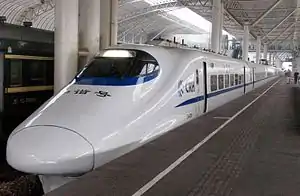
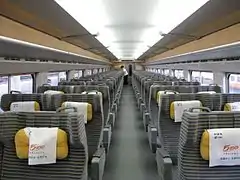 CRH2 First Class Coach
CRH2 First Class Coach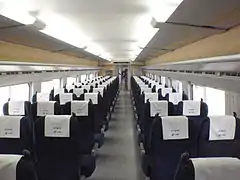 CRH2 Second Class Coach
CRH2 Second Class Coach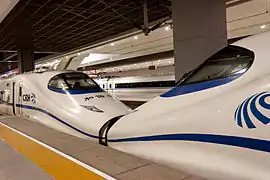 China CRH2C locomotives at Shanghai Hongqiao Station
China CRH2C locomotives at Shanghai Hongqiao Station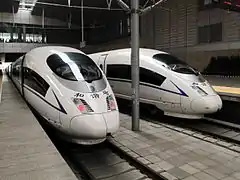
 Premier-class cabin inside Beijing-Tianjin Intercity CRH3 train
Premier-class cabin inside Beijing-Tianjin Intercity CRH3 train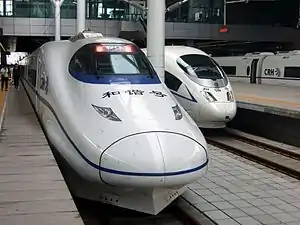 CRH2C and CRH3C at Tianjin railway station
CRH2C and CRH3C at Tianjin railway station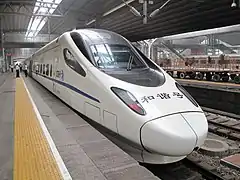

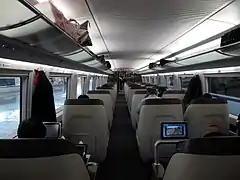 CRH380BL Business Coach
CRH380BL Business Coach.jpg.webp) CRH380CL at Beijing South railway station
CRH380CL at Beijing South railway station.jpg.webp) CRH380D at Beijing South railway station
CRH380D at Beijing South railway station
See also
- China Railway High-speed, Chinese high-speed railway service
- China Railway, Chinese state-owned corporation that operates nearly all Harmony trains.
- Fuxing (train), next-generation EMU developed by China with independent intellectual property rights.
References
- Shirouzu, Norihiko (2010-11-17). "Train Makers Rail Against China's High-Speed Designs". The Wall Street Journal. Retrieved 2012-12-26.
- Wines, Michael; Bradsher, Keith (2011-02-17). "China Rail Chief's Firing Hints at Trouble". The New York Times. Retrieved 2012-12-27.
Many multinational companies also resent China for tweaking foreign designs and building the equipment itself rather than importing it.
- Johnson, Ian (2011-06-13). "High-Speed Trains in China to Run Slower, Ministry Says". The New York Times. Retrieved 2012-12-27.
In the past few months, some foreign companies that sold China its high-speed technology said the trains were not designed to operate at 215 miles per hour. The ministry said that Chinese engineers had improved on the foreign technology and that the trains were safe at the higher speeds.
- Xin, Dingding (2011-06-28). "Full steam ahead for high-speed rail patents overseas". China Daily. Retrieved 2012-12-27.
- "High speed trainsets take shape". Railway Gazette International. 2005-08-01.
- "China's high speed fleet expands steadily". Railway Gazette International. 2007-08-01.
- 法中企业握手互利共赢. news.xinhuanet.com (in Chinese). 2004-10-25.
- "2004年10月12日,BSP与铁道部及广州铁路(集团)签订了20列(160辆)EMU动车组". www.bsp.cn (in Chinese). January 12, 2006. Archived from the original on July 7, 2011.
- "CRH2型动车组详细资料及分类". news.chineserailways.com (in Chinese). December 14, 2009. Archived from the original on August 23, 2011.
- 庞巴迪:又获铁道部动车组大订单. info.traffic.hc360.com (in Chinese). 2005-06-10.
- 西门子专家进驻唐山机车车辆厂. hebei.moform.gov.cn (in Chinese). August 15, 2006. Archived from the original on August 17, 2011.
- "BSP公司在北京签订40列EMU动车组订单". www.bsp.cn (in Chinese). November 2, 2007. Archived from the original on July 7, 2011.
- www.docin.com 招商证券-中国南车-601766-动车交付高峰来临,业绩逐季增.. (in Chinese).
- "公司与北京铁路局签订了30列CRH5型动车组采购合同". www.cccar.com.cnom (in Chinese). Archived from the original on July 17, 2011.
- 唐车公司拿到京沪高铁动车组大订单 总金额392亿. info.china.alibaba.com (in Chinese). 2009-03-17.
- 中国南车:中标巨额合同 增厚公司业绩. www.guosen.com.cn (in Chinese). 2009-09-30.
- "Zefiro 250NG included in revised high speed train contract".
- 长客签下235亿订单. jlrbszb.chinajilin.com.cn (in Chinese). 2009-09-28. Archived from the original on 2011-07-07. Retrieved 2018-03-23.
- www.docin.com 招商证券-中国北车-601299-动车组第三批高毛利率订单将陆续交付 (in Chinese).
- "关于CRH3和380B的提问". bbs.ourail.com (in Chinese). Archived from the original on 2011-08-12. Retrieved 2018-03-23.
- 中国南车获国内首个城际列车项目订单 总值23.46亿人民币 (in Chinese). Archived from the original on 2017-08-21. Retrieved 2018-03-23.
- "Bombardier Sifang Awarded Fourth Contract for 40 Additional CRH1 High-Speed Trains in China". cn.bombardier.com. 2010-07-16. Archived from the original on 2011-08-13. Retrieved 2018-03-23.
- 中国南车:再中标动车组订单、未来高增长确定::全景证券频道. www.p5w.net (in Chinese). 2010-09-30.
- "news.xinmin.cn/rollnews/2010/10/13/7194620.html". news.xinmin.cn (in Chinese). 2010-10-13.
- 中国南车研究报告:国金证券-中国南车-601766-通往春天的铁路设备龙头. docin.com (in Chinese). Archived from the original on 2011-07-23. Retrieved 2018-03-23.
- 国金证券-中国北车-601299-动车交付单价已触底,毛利率回升可期. docin.com (in Chinese).